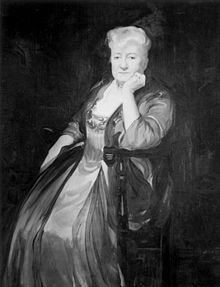Name Sara Stevenson Role Archaeologist | Died November 14, 1921 | |
 | ||
Books Maximilian in Mexico: A Woman, Maximilian In Mexico ‑ A Woman, With Maximilian in Mexico, Maximilian in Mexico a Woman | ||
Sara Yorke Stevenson (February 19, 1847 – November 14, 1921) was a prominent American archaeologist.
Contents
Well-connected in the cultural elite of Philadelphia, Stevenson joined many learned societies, and was believed to be America’s only woman Egyptologist. She is best remembered as a founder of the Penn Museum (University of Pennsylvania Museum of Archaeology and Anthropology). As a female rights activist, she established the Equal Franchise Society of Pennsylvania.
Family
Sara’s parents were Edward (d. 1868) and Sarah Hanna Yorke, Louisiana citizens who moved to Paris during the 1840s. They both came from established families; her mother's family owned a large cotton plantation, and her father was a cotton broker.
Early life
Sara’s parents moved back to the States when she was only ten, leaving their daughters to attend boarding school in France. She stayed in Paris from 1858 through 1862 attending school, after which she joined her family in Mexico, where they had moved because of some investments of her father's. In Mexico she attended many social gatherings of the newly appointed Empress of Mexico Charlotte of Belgium and her husband Maximilian. Her first-hand account of the Second Mexican Empire gave great insight into the inner workings of court life during that time. In 1867 the family relocated to Vermont following some violence in Mexico. Stevenson's father died only a year later and not long after that she moved to Philadelphia to live with two Yorke uncles and an aunt.
Marriage
Sara married Cornelius Stevenson, a Philadelphia lawyer, on June 30, 1870. They had one child, William Yorke Stevenson (1878-1922).
Associates
Stevenson was part of a group of internationally known Philadelphia elite scholars, known as the Furness-Mitchell Coterie, who were a driving force in many areas, especially anthropology, during the late nineteenth and early twentieth centuries. The group included musicians, writers, scholars, anthropologists, and educators. Because of her involvement in the group Stevenson was able to enjoy privileges that would not have been possible without her involvement in the coterie.
She was an active member of Philadelphia society and served as president of clubs such as the Civic Club of Philadelphia and the Acorn Club.
Career
In the 1880s anthropology was just becoming a discipline as universities were beginning to develop their anthropology departments. Stevenson was known as an "armchair archaeologist" or anthropologist; she never carried out her own fieldwork, but analyzed the information that others had collected. "Anthropological Work in America", an article in the July 1892 issue of Popular Science Monthly, declared that Stevenson "is perhaps our only lady Egyptologist. Her lectures in Egyptian subjects have made a sensation." She mentored with Frederick Ward Putnam, who had just established Harvard's anthropology department, along with Franz Boas, Zelia Nuttall, and Alice Fletcher. Stevenson's interests were very wide; she was interested in everything from cultural diffusion to cultural evolution.
In 1892 Putnam supported Stevenson's appointment to the Jury of Awards for Ethnology. A special act had to be passed to allow a woman to serve this position; Stevenson was elected vice president of the jury. In 1894 Stevenson was the first woman to speak at the Peabody Museum on "Egypt at the Dawn of History". She was president of the Oriental Club of Philadelphia, the Contemporary Club, and the Pennsylvania Chapter of the Archeological Institute of America and was founder and officer of the University Archaeological Association, the American Folk-Lore Society and the American Exploration Society. She was also a member of the Numismatic and Antiquarian Society of Philadelphia and in 1895 was admitted to the American Philosophical Society. Stevenson also joined the American Association for the Advancement of Science in 1884 and was nominated a Fellow in 1895. She also established the Equal Franchise Society of Pennsylvania, in recognition of the difficulties women faced. She served as president until 1910 and first vice president until the Federal Suffrage Amendment passed in 1920.
Stevenson's greatest contribution was her role in the establishment of the University of Pennsylvania Museum of Archaeology and Anthropology (Penn Museum). In 1891, Stevenson, Pepper, Talcott Williams, and Joseph Coates were appointed by the University Archaeological Association to create a department of archaeology and paleontology to manage the museum. Stevenson then served on the governing board from its start until 1905. She also served as the curator of the Egyptian and Mediterranean section of the museum from 1890 to 1905.
In addition to all these achievements, Stevenson pursued various non-archaeological interests, including becoming a columnist for the Philadelphia Public Ledger under the pen names "Peggy Shippen" and "Sally Wistar". As one of the principal founders of the University Museum, one whose contributions to the building program of the Museum was essential to its success, Stevenson set a powerful example for generations of women to follow.
Following her departure from the Penn Museum in 1905 Stevenson developed one of the first college-level courses in training museum professionals in the United States, which she taught at the Pennsylvania Museum and School of Industrial Art, now known as The University of the Arts (Philadelphia).
